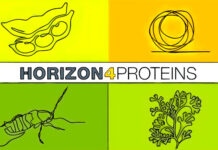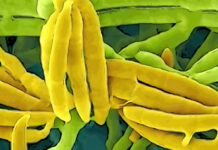EFSA(European Food Safety Authority) has issued a scientific opinion favoring the novel foods authorization of partially hydrolyzed proteins from barley and rice brewers’ grains, obtained by upcycling beer co-products. (1)
1) Hydrolyzed protein from barley and rice hulls, the novel food
The novel food proposed by Evergrain LLC (ABInBev Group) is a powder made from the concentration of proteins extracted from barley(Hordeum vulgare) and rice(Oryza sativa) grains that are left over from the brewing process by an enzymatic process followed by mechanical processes.
The enzymes used (glucoamylase, pullulanase, serine protease) come from recombinant, genetically modified microorganisms of the species Aspergillus niger and Bacillus licheniformis. The risk assessment focused on demonstrating the absence of recombinant DNA (< 10 ng DNA/g) and live, viable cells in the product, as required in EFSA’s guidance on dossier submission for food enzymes. (2)
The uses of novel food as a food ingredient are many, in a variety of products for the general population (see Fig. 1). The vegan proteins, marketed in 20 kg paper bags, can be stored at room temperature for 15 months due to their low humidity.

2) Production process
The production of the novel food under consideration has two stages, enzymatic and mechanical.
2.1) Enzymatic phase
The leftover grains from the wort mashing and filtration stage are pasteurized and fed into a bioreactor for the protein hydrolysis stage, with water added in a predetermined ratio. This is followed by mixing under stirring, at temperature > 68° C, at atmospheric pressure, for 3 hours.
The mixture is brought to operating temperature (unknown) and treated with a mix of glucoamylase and pullulanase from recombinants for 45 minutes to hydrolyze the starch. After pH correction to 9.0, recombinant serine proteases(B. licheniformis) are used to hydrolyze the proteins. A heat treatment deactivates the enzymes,
2.2) Mechanical phase
The solid residues and protein extract are separated by centrifuges, in an extraction tank. Precipitated solids are diluted with water, if necessary pressed with a screw press, to promote protein recovery and increase yields (as well as reduce moisture content and improve stability). Instead, the protein liquid undergoes microfiltration (0.1 um at 70-80° C), with several cyclic diafiltration steps to increase protein recovery in the permeate (the filter-separated phase).
The fraction retained by the filter contains fat and fiber, as well as high molecular weight protein. It is therefore subjected to nanofiltration, resulting in a product with about 20 percent solids, of which 85 percent are raw proteins. Evaporation then allows the solids concentration to be increased up to 50 percent, which are subjected to pasteurization and spray-drying to obtain protein powder that is stored in containers and/or packed in paper bags.
3) Nutritional properties, digestibility of protein
Hydrolyzed protein powder from barley and rice grains contains about 85% protein, 6% carbohydrates, < 2% fat, with an energy value of 367 kcal/100 g. The content of vitamins and minerals, and anti-nutritional factors normally found in cereals (e.g., phytates, tannins, lectins, trypsin inhibitors) is believed to be in line with conventional foods. Thus, the introduction of novel food in the EU poses no risk of nutritional disadvantage.
The digestibility of hydrolyzed proteins from barley and rice grains-assessed by the DIAAS method, which measures fecal or intestinal absorption of their amino acids-is 65 percent, not far from the minimum value attributed to good quality proteins (75 percent). It is variably reduced, with a DIAAS value in the 38-63% range, when added to other foods. And it is low in infants (0-6 months) and toddlers (6 months – 3 years), at 45% and 55%, respectively.
The Nutrition, Novel Foods and Food Allergens (NDA) scientific panel in EFSA therefore assessed the fate of this novel food to the ‘infants up to 6 months’ group as inappropriate. Also highlighting the possible nutritional safety risks for other population groups with low baseline protein intakes if trebbia protein replaces other sources of higher quality protein. (3)
4) Toxicity and allergenicity
The well-established history of use of the raw materials barley and rice in human nutrition, their use in the brewing industry, and the widespread use of threshing as feed led EFSA not to require toxicological studies on the candidate novel food under consideration.
Barley is already on the list of allergens in the Food Information Regulation (EU) No 1169/2011, Annex II, due to gamma-3 hordeins and nonspecific lipid transport proteins. As well as possible cross-reactivity with wheat, rye, oats and Job’s Tears.
Rice-while not on the list of allergens subject to mandatory specific information in the EU-contains some proteins that can cause allergic reactions (alpha-amylase inhibitors, beta-expansins, profilin A). And cross-reactivity is also present in rice with barley, oats, wheat, rye, soybean, corn, field pollen, and triticale.
5) Data protection, possible exclusivity
The European Food Safety Authority (EFSA) acknowledged that many data and studies submitted by the applicant were necessary to draw conclusions about the safety of the novel food. The applicant submitted a request for data protection and some submitted studies.
The European Commission will therefore have to decide whether to grant Evergrain LLC a five-year exclusivity on novel food authorization. So as to prevent others, for the next 5 years, fromupcycling protein from threshers in the manner indicated (unless obtaining license from Evergrain or submitting new application).
6) Other foods from threshing, barley, rice
Novel Food Catalogue
, the dossiers of the consultation processes in this regard, and the Union’s list of novel foods (EU Regulation 2017/2470) indicate other foods that can be obtained, used or marketed from the grains or their sources, and their conditions of use (4,5,6).
6.1) Trebbie
By themselves, the grains-characterized by fiber and some protein fractions, along with a low chaff content-are considered traditional foods. The European Commission has commented on this in a consultation process initiated by the Netherlands on two powders with 50 percent and 70 percent protein, intended for use as ingredients in cookies and whole-wheat breads. In this regard, both the absence of a significant chemical change in the structure of the food and the simplicity of the production process were considered, based on data provided by the applicant. Conversely, chaff alone is considered to be a novel food.
6.2) Barley
The cereal barley is traditionally used both as a food, in various forms (e.g., as a foodstuff. soluble barley, pearl barley, flakes, malt, juice, etc.), both as an ingredient in various foods (e.g., soups, grain products, soups) and beverages (e.g., beer, whiskey, malts), as well as for animal feed.
6.3) Rice
The tradition of eating rice is also well established, in Europe as in other continents. Rice bran oil itself, extracted from the aleurone layer and germ, is not considered to be a novel food.
The fungal fermentation of rice and pea concentrates resulted in a high-protein powder (> 75%), instead subjected to the novel food approval procedure. (7)
7) Interim Conclusions
The plant proteins covered in the EFSA scientific opinion under review demonstrate how research and innovation can be usefully directed toward upcycling pathways aimed at valorizing by-products. Indeed, the circular economy applied to food systems makes it possible to:
– produce food and/or food ingredients, with both having the possible benefits of reducing raw material costs and/or increasing the added value of final products,
– Reduce food loss and waste (in this case food loss),
– Minimize environmental waste management burdens and costs,
– Create new economic and job opportunities.
#wasteless
Dario Dongo and Andrea Adelmo Della Penna
Notes
(1) EFSA NDA Panel (2023). Safety of partially hydrolysed protein from spent barley (Hordeum vulgare) and rice (Oryza sativa) as a novel food pursuant to Regulation (EU) 2015/2283. EFSA Journal 21(9):8064, https://doi.org/10.2903/j.efsa.2023.8064
(2) EFSA CEP Panel (2021). Scientific guidance for the submission of dossiers on Food Enzymes. EFSA Journal 19(10):6851, https://doi.org/10.2903/j.efsa.2021.6851
(3) Dario Dongo, Andrea Adelmo Della Penna. Animal foods needed for nutrition and health, FAO report. GIFT(Great Italian Food Trade). 8.5.23
(4) European Commission. EU Novel food catalogue https://webgate.ec.europa.eu/fip/novel_food_catalogue/
(5) European Commission. Consultation process on novel food status https://food.ec.europa.eu/safety/novel-food/consultation-process-novel-food-status_en
(6) Commission Implementing Regulation (EU) 2017/2470 of December 20, 2017 establishing the Union list of novel foods under Regulation (EU) 2015/2283 of the European Parliament and of the Council on novel foods. Consolidated text as of 8/22/23 http://data.europa.eu/eli/reg_impl/2017/2470/2023-08-22
(7) Dario Dongo, Andrea Adelmo Della Penna. Novel food. Green light in EU for protein from mushrooms, rice and peas, insects, milk and new sugars. GIFT(Great Italian Food Trade). 14.1.23
Dario Dongo, lawyer and journalist, PhD in international food law, founder of WIISE (FARE - GIFT - Food Times) and Égalité.








